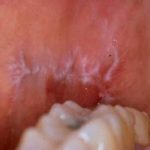
Oral lichen planus (OLP) is a chronic disorder of the oral cavity that is thought to affect 1% to 2% of the population, mainly middle-aged adults with women slightly more likely to have the condition. OLP is probably a T cell-mediated condition and various treatments have been employed to treat ulcerative lesions and pain.
The aim of this Cochrane review was to assess the effectiveness and safety of corticosteroids for the treatment of people with oral lichen planus.
Methods
Searches were conducted in the Cochrane Oral Health’s Trials Register, the Cochrane Central Register of Controlled Trials (CENTRAL), Medline, Embase, the US National Institutes of Health Ongoing Trials Register (ClinicalTrials.gov) and World Health Organization International Clinical Trials Registry Platform with no restrictions on language or date of publication. Randomised controlled trials (RCTs) of any local or systemic corticosteroid treatment compared with a placebo, a calcineurin inhibitor, another corticosteroid, any other local or systemic (or both) drug, or the same corticosteroid plus an adjunctive treatment were considered. The primary outcome was patient assessed pain (score and resolution) at the end of treatment.
Three reviewers selected studies, extracted data and assessed risk of bias using the Cochrane domains-based tool. For dichotomous outcomes, estimates of effects were expressed as risk ratios (RR), with 95% confidence intervals (CI) with mean differences (MD) and 95% CI for continuous outcomes. Meta-analyses were carried out for studies of similar comparisons reporting the same outcome measures and the overall certainty of the evidence assessed using GRADE.
Results
- 35 RCTs involving 1474 patients were included.
- 7 trials were considered to be at low risk of bias, 17 at high risk of bias and 11 at unclear risk.
Corticosteroids versus placebo
- 3 studies evaluated the effectiveness and safety of topical corticosteroids in an adhesive base compared to placebo.
- 2 studies (72 patients), one evaluating clobetasol propionate and the other flucinonide were combined in a meta-analysis. There was low-certainty evidence that pain may be more likely to be resolved when using a topical corticosteroid rather than a placebo. RR =1.91 (95%CI; 1.08 to 3.36). The results for clinical effect of treatment and adverse effects were inconclusive
Corticosteroids versus calcineurin inhibitors
- 3 studies compared topical clobetasol propionate versus topical tacrolimus. with low-certainty evidence of any difference between tacrolimus and clobetasol for the outcomes:
| Studies (patients) | Risk ratio (95%CI) | |
| Pain resolution | 2 (100) | 0.45 (0.24 to 0.88) |
| Clinical resolution | 2(52) | 0.61 (0.38 to 0.99 |
| Adverse effects | 2 (100) | 0.05(0.00 to 0.83) |
- One study (39 patients) compared topical clobetasol and ciclosporin, and provided only very low-certainty evidence for:
- rate of clinical resolution with clobetasol RR= 3.16 (95%CI; 1.00 to 9.93)
- pain resolution = RR 2.11 (95%CI; 0.76 to 5.86) and
- adverse effects =RR 6.32 (95%CI; 0.84 to 47.69).
- Two studies (60 patients) that compared triamcinolone and tacrolimus found uncertain evidence regarding the rate of clinical resolution, RR = 0.86 (95%CI; 0.55 to 1.35) [very low-certainty evidence] and that there may be a lower rate of adverse effects in the triamcinolone group, RR = 0.47 (95%CI; 0.22 to 0.99)[low-certainty evidence]. These studies did not report on pain resolution.
Conclusions
The authors concluded: –
Corticosteroids have been first line for the treatment of OLP. This review found that these drugs, delivered topically as adhesive gels or similar preparations, may be more effective than placebo for reducing the pain of symptomatic OLP; however, with the small number of studies and participants, our confidence in the reliability of this finding is low. The results for clinical response were inconclusive, and we are uncertain about adverse effects. Very low-certainty evidence suggests that calcineurin inhibitors, specifically tacrolimus, may be more effective at resolving pain than corticosteroids, although there is some uncertainty about adverse effects and clinical response to tacrolimus showed conflicting results.
Comments
This review of treatments for oral lichen planus is an update of an earlier Cochrane review although the review only focuses on the use of corticosteroids with a separate review being conducted into non-corticosteroid treatments for OLP. Corticosteroids have been a first-line treatment for symptomatic OLP for some years and while the findings suggest that it may be more effective than placebo the available evidence supporting its use of of very low certainty. As the authors’ note there is a need to further high-quality well reported studies that compare different topical corticosteroids and corticosteroids with calcineurin inhibitors, different doses and treatment lengths, particularly in relation to long-term relapses and adverse effects.
Links
Primary Paper
Lodi G, Manfredi M, Mercadante V, Murphy R, Carrozzo M. Interventions for treating oral lichen planus: corticosteroid therapies. Cochrane Database of Systematic Reviews 2020, Issue 2. Art. No.: CD001168. DOI: 10.1002/14651858.CD001168.pub3.
Other references
Dental Elf – Oral Lichen Planus blogs
Photo credits
By James, Candice, Mai – http://bohone09.wikispaces.com/Group+1, CC BY-SA 3.0,

See also the @CochraneOHG blog about this review at https://bit.ly/39uS6XX